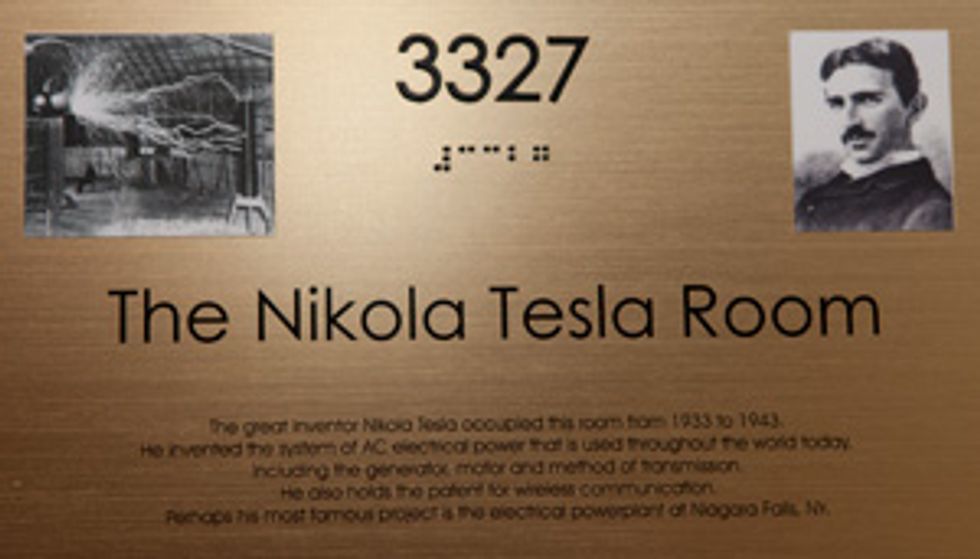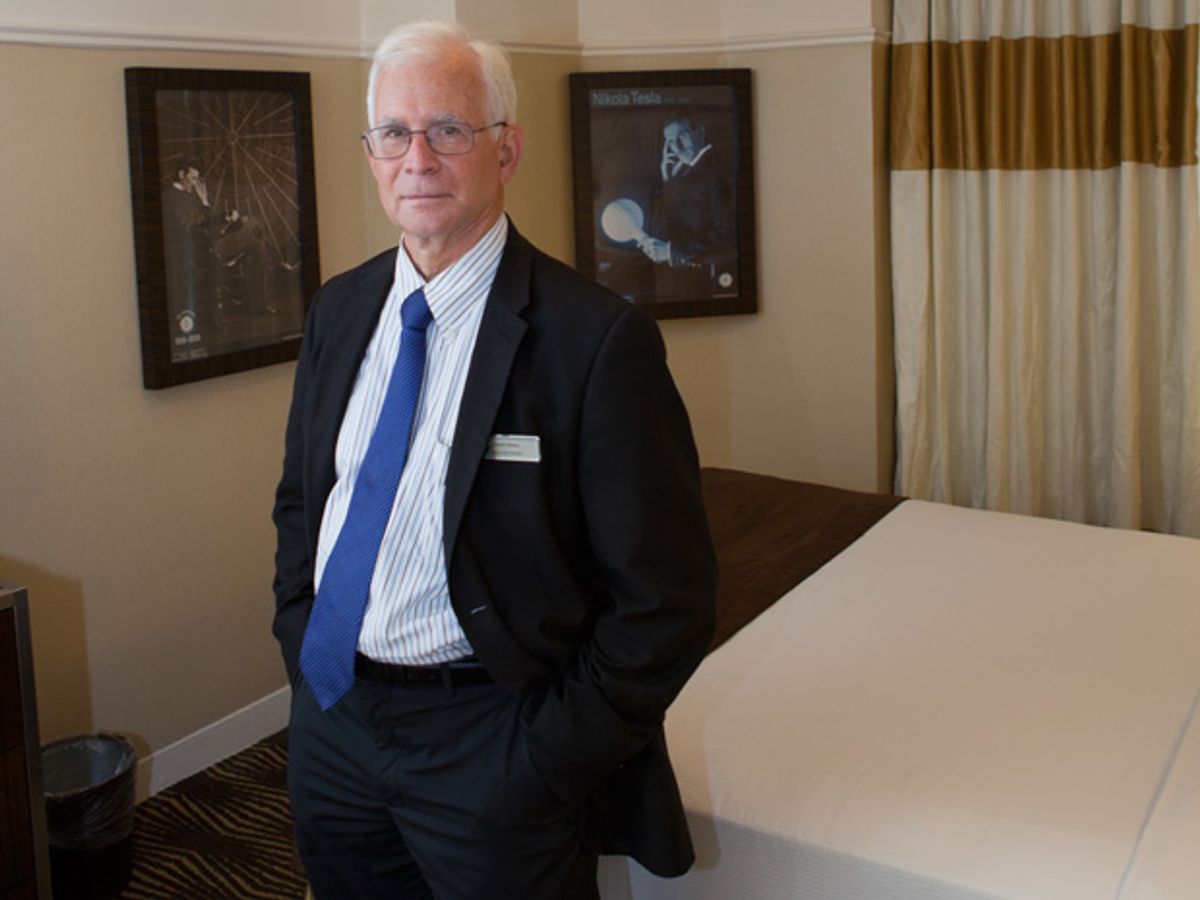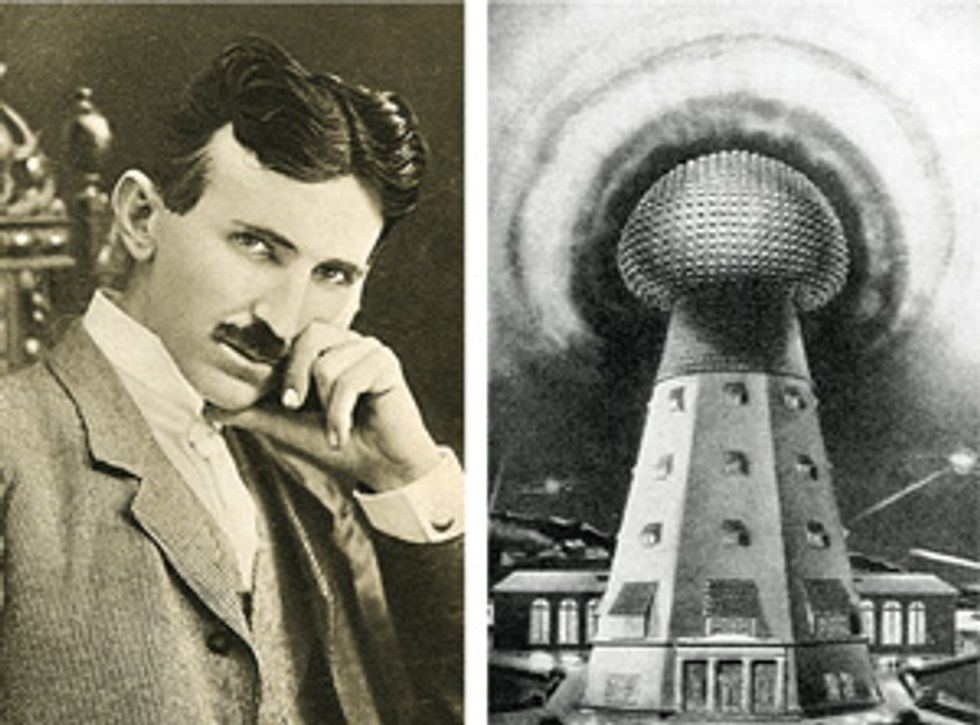Outside the 34th Street side of the Wyndham New Yorker Hotel in Manhattan, it seems fitting that lightning cracks the sky as Joseph Kinney [left] points to a plaque recognizing that the father of AC power, Nikola Tesla, once lived at the hotel. That very few among the thousands of people walking by each day realize that the inventor and engineer once rivaled Thomas Edison, Alexander Graham Bell, and Henry Ford for the mantle of greatest American inventor is why Kinney has spent nearly 20 years championing Tesla.
Kinney, the chief building engineer for the hotel as well as its unofficial historian, is a 63-year-old bespectacled man with white hair and a perpetual twinkle in his eye. His sarcasm and intensity often ignite a rather goofy, high-pitched chortle. Dressed in tie and jacket despite the oppressive humidity of a hot summer day, he is clearly proud of the Tesla plaque, which reads, in part: “Here died, on January 7, 1943, at the age of 87, the great Yugoslav-American scientist-inventor.”
Moving through the hotel’s art deco lobby, we descend the stairs to Kinney’s subterranean office, and he talks as we go. “This hotel is the only place in the country where Tesla spent a lot of time and that still exists much as it was when he was alive,” says Kinney. “Everyplace else is either demolished or radically changed.”
From 1933 until his death in 1943, Tesla lived in relative obscurity at the New Yorker Hotel with little means. Considered quirky, he loved pigeons and was known to spend time every day in nearby Bryant Park visiting them or feeding them from the windows of his room. Tesla’s New York Times obituary refers to his claims about death beams and communications from Mars.

But in his earlier days, Tesla made critical contributions to establishing electricity as the ubiquitous workhorse it is today. Electrical power was still a novelty when the Croatian-born, ethnic Serbian visionary arrived in New York City with pennies in his pocket at the age of 28 in 1884. He also had a head full of ideas, many of them formed while working for the Continental Edison Company in France. He worked on improving Edison’s DC system, but he fell out with Edison over pay. Eventually, Tesla found a backer in Pittsburgh industrialist George Westinghouse for his designs for motors and transformers that used AC.
The rivalry between the backers of AC and DC power became known as the War of Currents. In the end, AC power triumphed over DC power, and Tesla conducted many spectacular, well-attended high-voltage power demonstrations, including a high-profile appearance at the Chicago World’s Fair (formally known as the World’s Columbian Exposition) in 1893. Edison, shortly before his death in 1931, said that one of the biggest mistakes of his life was his failure to back AC power.
But inventing AC power failed to sustain Tesla, who foolishly released Westinghouse from the royalty agreements that should have made him a rich man. He received backing from J.P. Morgan to build a laboratory and a huge radio tower to pursue ideas for transatlantic telecommunication and wireless power transmission technologies. The promised results never materialized, and the tower was scrapped. No longer able to afford a laboratory, Tesla continued to privately pursue his experiments in places like the New Yorker Hotel. His death in 1943 was barely acknowledged; World War II was consuming the country, and his major accomplishments had come more than four decades before.
But recognition for Tesla has been on the rise in recent years, with, for example, the unveiling of a statue in the heart of Silicon Valley. The biggest grassroots effort is the construction of the Tesla Science Center on the 16-acre Wardenclyffe site, in Shoreham, N.Y., where Tesla built the J.P. Morgan–funded laboratory. One of the effort’s leaders is Matthew Inman, a cartoonist and Tesla fan who runs the popular blog The Oatmeal and who recently solicited a US $1 million donation from Elon Musk, the billionaire founder of Tesla Motors.
Prior to this Tesla revival, however, Kinney was one of the few people keeping the inventor’s memory alive. William Terbo, Tesla’s 84-year-old grandnephew—who was one of the last people to see Tesla alive, when he visited him at the hotel as a 9-year-old—says that before Kinney was hired, Tesla proponents had been unable to convince management to publicly recognize that the inventor had spent the last 10 years of his life there. Kinney convinced the hotel to move a memorial plaque to the outside of the building in 2001; to officially recognize rooms 3327 and 3328, in which Tesla lived and worked; and to put a Tesla poster in the hall outside the rooms.
Kinney first heard about Tesla while growing up in Memphis, Tenn. As a teenage amateur radio enthusiast, he learned about the Tesla coil, a transformer circuit used to produce high-frequency, high-voltage AC. Now Tesla enthusiasts contact Kinney weekly, and he finds himself giving tours and dispensing information like a de facto publicist. Kinney once described to the New Yorker magazine the three types of visitors he received: “Electrical engineers and technology enthusiasts; people interested in UFOs, anti-gravity airships, death-ray weapons, time travel, and telepathic pigeons; [and] Serbs and Croats.”
In Kinney’s basement office, shelves are crammed with Tesla memorabilia, including a book signed by Božidar Đelić, who was vice president of Serbia from 2007 to 2011. Kinney’s favorite hobby is photography, and his hard drive contains hundreds of Tesla-related shots, including archival portraits and a photo that Kinney took in 2006 of the presidents of Croatia and Serbia shaking hands in front of the Tesla plaque. “Yes, I’ve collected a lot of material, but I don’t consider myself as a resource,” he says modestly. “Others have studied the man in a much more substantial way. I’m just someone with the keys to Tesla’s house and who has kept the front door open.” (While Kinney may not consider himself a resource on Tesla, the producers of a Travel Channel program thought differently when they chose him to narrate Tesla’s story in a “Hotel Secrets & Legends” segment.)
Tesla’s two rooms—which still accommodate paying guests—are often requested by devotees from around the world. During a tour, Kinney knocked before using a passkey to open one door, and a quick peek in revealed an ordinary hotel room with two Tesla posters hanging on the walls. Kinney says Tesla used the rooms together and points to a spot in the hallway where a door once set off the rooms as a suite.
One request for a Tesla room came from actor Nicolas Cage, who stayed for a night in 2010 while preparing for his role as a wizard who throws balls of electricity in The Sorcerer’s Apprentice. “Cage was trying to ‘call up the spirits’ and believed something hit the window, and he suggested it may have been a pigeon,” says a bemused Kinney.
Read the backstory on how the author met first met Kinney during his daily commute.
This article was corrected on 31 October 2014.

